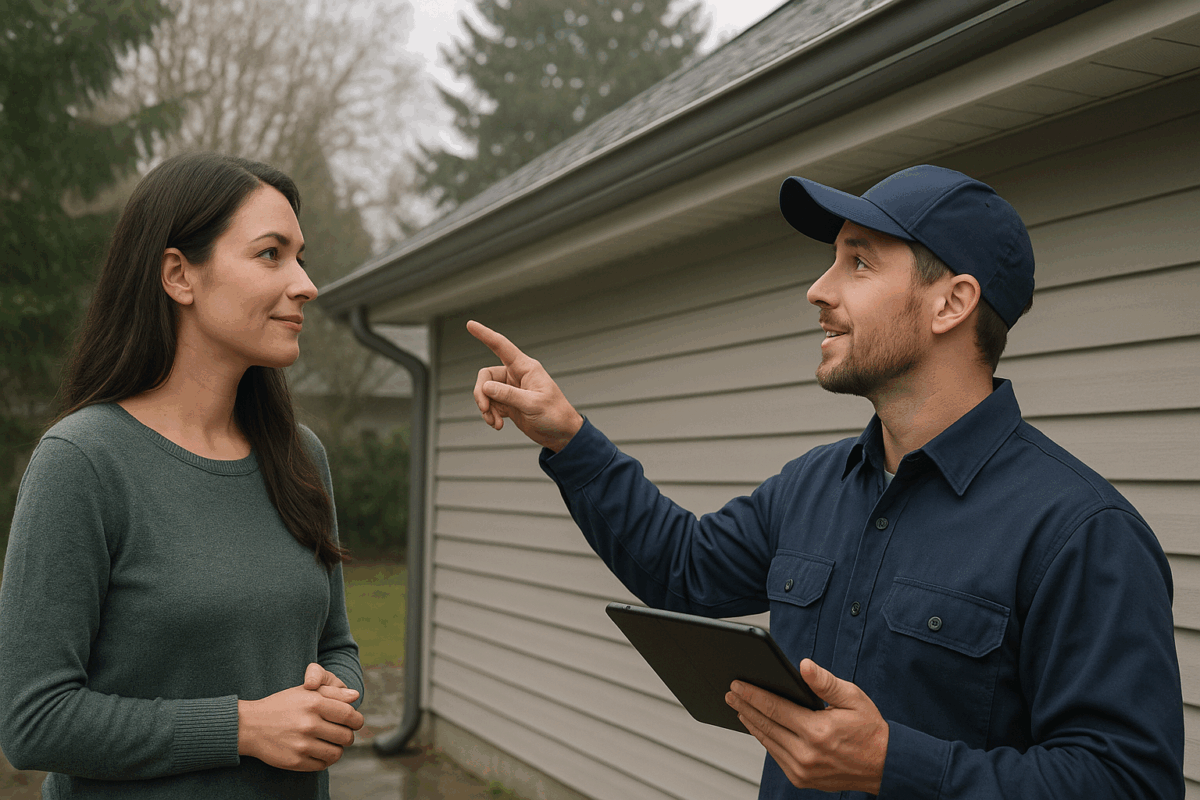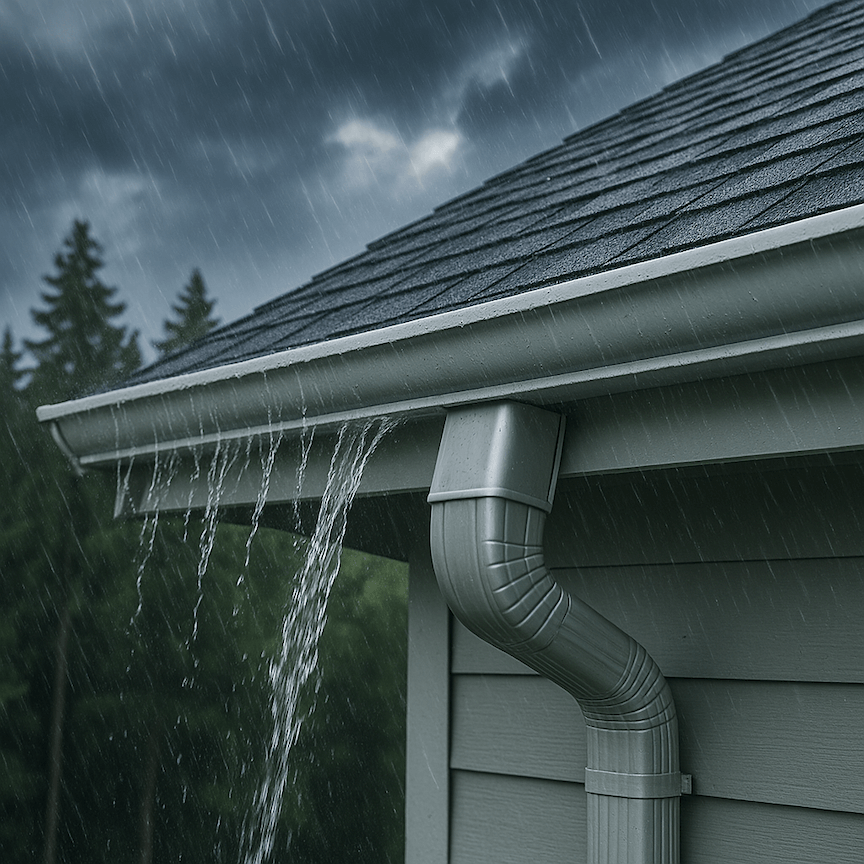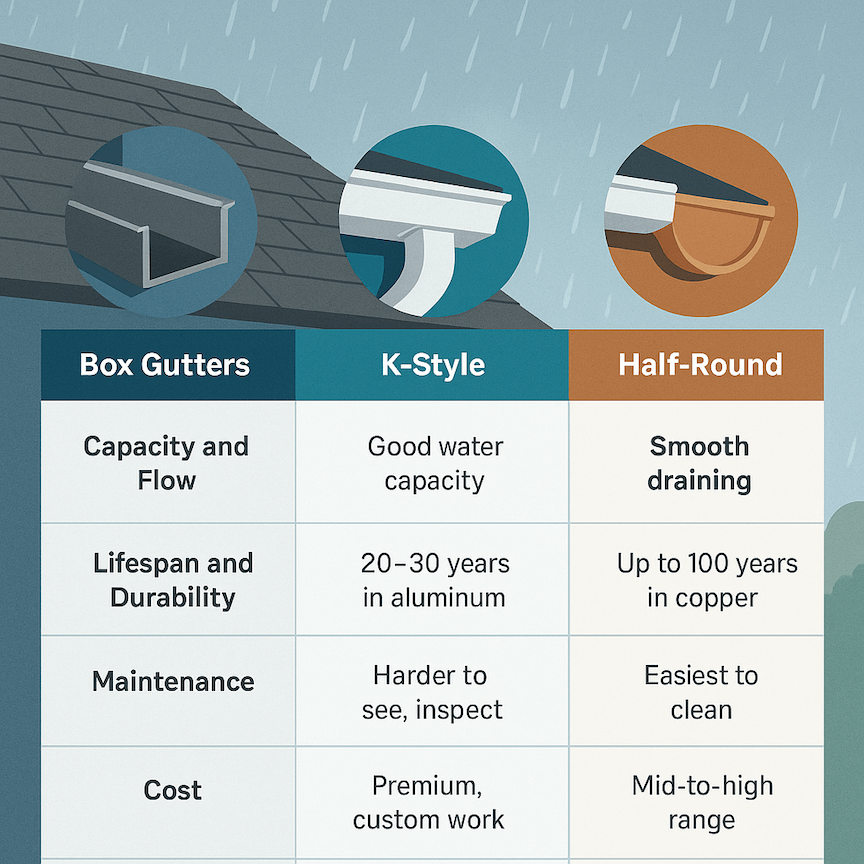Heavy rain has a way of revealing problems you never noticed before. You might be standing at the window during a storm, thinking everything looks normal, and then you hear a rush of water spilling straight over the edge of the gutter like a tiny waterfall.
Later, you climb a ladder, expecting a big clog, and find nothing. The trough is basically clean. That moment usually catches people off guard because the issue is something they never thought to check: the gutter pitch.
In Washington, this small detail has an outsized impact. Our storms hit hard, pine needles drop constantly, and roof debris builds up even when you maintain your gutters. A pitch that’s even slightly off can turn a working system into one that overflows the moment the rain intensifies.
This blog breaks down what gutter pitch is, why it fails so often here, and how small errors in slope can snowball into real home damage. It also explains why professional help matters, whether you’re looking into gutter installation or a more targeted fix.
What Is Gutter Pitch and Why Does It Matter?
A lot of homeowners assume their gutters should look perfectly level, but they’re supposed to slope just a bit. That slope, called the gutter pitch, keeps water moving toward the downspout instead of pooling. It’s not a dramatic tilt, and you shouldn’t see it from the ground. But it must be precise enough for water to flow without hesitation.
Pitch works on a kind of “Goldilocks rule.” If the slope is too steep, the gutter looks crooked, and water shoots forward too fast. If the slope is too flat, water forms long puddles. These puddles trap pine needles, grit, and moss. And when pitch changes along the run, which happens when screws loosen or the gutter bends, you get sagging sections that behave like tiny bathtubs.
Professionals usually aim for around a quarter inch of downward slope for every ten feet. If the pitch is wrong by even a small amount, your system might overflow despite being clean. This is a common reason Washington homeowners assume they need seamless gutters installation, when the main issue is uneven slope.
A few signs the pitch is failing:
- Water remains in the gutter long after the rain stops.
- Overflow happens only in one or two specific spots.
- A section looks “off” or slightly lower than the rest.
Why Washington’s Climate Is a Perfect Storm for Pitch Problems
Rain in this region behaves differently than in many parts of the country. Storms often arrive in short, intense bursts that drop huge amounts of water in minutes. If the pitch isn’t guiding that water forward, even an open gutter fills up and spills over the front edge.
Pine needles make this worse. Washington’s evergreens shed constantly, and those long needles settle into low spots created by poor pitch. They mat together when soaked, forming a blockage that’s almost like a filter, slowing water even more. As the blockage grows, the weight increases. The gutter dips a little farther, and the pitch moves from “slightly off” to “basically flat.”
Climate patterns have also been shifting. Atmospheric rivers, sudden heavy downpours, and wind-driven storms are becoming more common. Gutters that drained well ten years ago now struggle to keep up with faster rainfall. Homeowners often look for gutter repair near Vancouver, WA, not realizing the root cause is a subtle slope issue.
The Domino Effect of a Poor Pitch
A gutter doesn’t fail all at once. It usually happens in a slow, chain reaction. One small problem sets up the next one, then the next.
Standing Water
This is almost always the first clue. Water remains in the gutter even after the rain clears. Standing water corrodes metal, attracts insects, and grabs onto debris. It also encourages algae and moss growth, which only adds more weight.
Gutter Sagging and Pull-Away
When water and debris collect in a single low spot, the gutter begins to sag. Screws loosen, and hangers bend.
Once it sags, the pitch changes again, and water drains even more slowly. Homeowners often assume they just need rain gutter repair, but the pitch is usually the reason the sag formed in the first place.
Fascia Damage
As the gutter dips, water begins to spill behind it rather than into it. Over weeks and months, that moisture soaks into the fascia boards. Paint peels, wood softens, and eventually the boards start to rot. At that point, the fasteners holding the entire system fail more easily.
Foundation Erosion
When gutters overflow in the same spot during every storm, water lands right at the base of the house. Soil erodes, and crawl spaces become damp. If the home has a basement, moisture can begin seeping in. The problem started on the roofline, but the consequences moved downward.
Some homeowners assume they need gutter replacement, even though the pitch adjustment is the real fix.
Why Professional Installation and Repair Are Non-Negotiable
Pitch is one of those things you can’t eyeball from the ladder. The difference between “works” and “doesn’t work” is often a matter of fractions of an inch. Professionals use string lines, levels, and, sometimes, lasers to measure the slope along the full length of the gutter.
This is one of the main reasons people choose seamless gutter installation. A seamless system lets the installer control the pitch from end to end because the gutter is custom-formed as a single long piece. There are no seams to catch debris or shift over time. It’s basically the cleanest way to ensure the slope stays consistent.
But not every situation needs a new system. Sometimes the downspout is the bottleneck, and you only need downspout repair near Vancouver, WA, to restore proper flow. Other times, the gutter needs to be rehung with new brackets. A pro can spot the difference by checking the slope, outlet placement, condition of the fascia, and strength of the hangers.
Secure Your Home’s First Line of Defense
Your gutters help manage thousands of gallons of rainwater every year. Their pitch decides whether that water moves away safely or spills right over the edge during the next storm.
In Washington’s climate, small mistakes become big problems fast. Water damage has a way of sneaking through the weakest points of a home, and a misaligned gutter is often one of those weak points.
If you’re hearing overflow during storms, seeing water sit in the trough, or noticing sections that look slightly lower than they should, it’s worth addressing the issue sooner rather than later. A simple adjustment can prevent a long list of repairs, from soaked fascia to eroded soil.
If you want help protecting your home, contact Gutter Empire at (971) 777-9899 to schedule a professional pitch evaluation or repair appointment.




